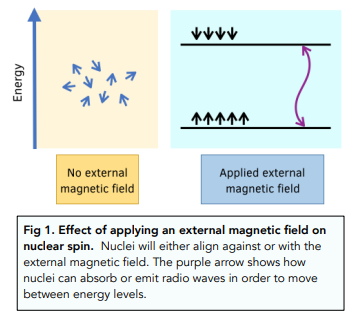Analytical Techniques - Nuclear Magnetic Resonance Spectroscopy (A-Level Chemistry)
Nuclear Magnetic Resonance Spectroscopy
What is Nuclear Magnetic Resonance?
Nuclear Magnetic Resonance (NMR) has been used by chemists since the 1950s.
It is one of the most powerful spectroscopic methods of determining the structure of molecules.
There are two main types of NMR spectroscopy:
- ¹³C NMR – gives you information about the arrangement of carbon atoms in an organic molecule
- ¹H NMR – gives you information about the arrangement of hydrogen atoms in an organic molecule.
How does NMR work?
The nucleus of some atoms, e.g. ¹H and ¹³C which have an odd number of neutrons and protons, have a property known as nuclear spin.
As a result of their spinning motion, these nuclei have their own weak magnetic field, rather like a bar magnet. NMR spectroscopy analyses how these tiny magnetic fields react when placed in a much larger magnetic field.
When samples containing these nuclei are placed in a much larger magnetic field, the “bar magnets” can either align themselves with a low-energy state or these can oppose it with a higher energy-state.
When electromagnetic radio waves are then fired at a sample within the larger magnetic field, energy from these waves is absorbed and nuclear spin changes from a low-energy state to a high-energy state.
These absorptions are call resonances and are recorded on the NMR spectrum.

Other atoms and groups of atoms that are around a nucleus will affect the amount of electron shielding and hence the strength of the magnetic field.
The nuclei in the molecules will therefore experience different magnetic fields depending on the types of atoms surrounding it, and this in turn affects the amount of energy absorbed by radio waves, and hence the reading on the spectrum.





Still got a question? Leave a comment
Leave a comment